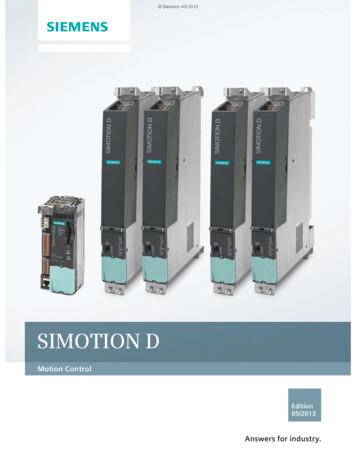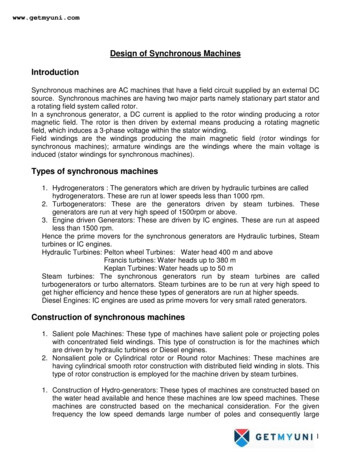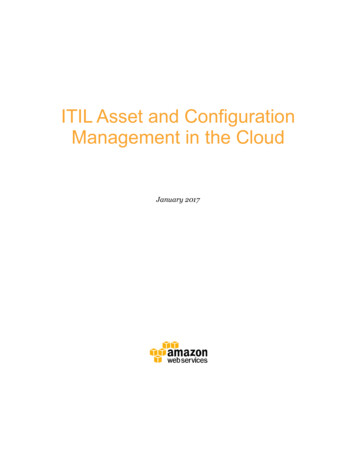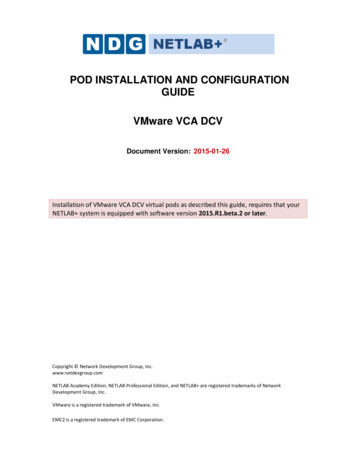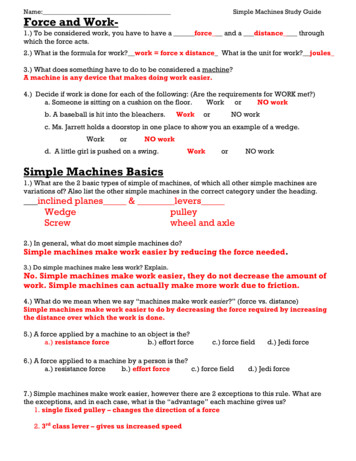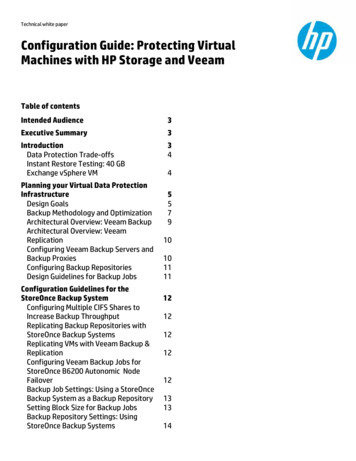
Transcription
Technical white paperConfiguration Guide: Protecting VirtualMachines with HP Storage and VeeamTable of contentsIntended Audience3Executive Summary3IntroductionData Protection Trade-offsInstant Restore Testing: 40 GBExchange vSphere VM34Planning your Virtual Data ProtectionInfrastructureDesign GoalsBackup Methodology and OptimizationArchitectural Overview: Veeam BackupArchitectural Overview: VeeamReplicationConfiguring Veeam Backup Servers andBackup ProxiesConfiguring Backup RepositoriesDesign Guidelines for Backup JobsConfiguration Guidelines for theStoreOnce Backup SystemConfiguring Multiple CIFS Shares toIncrease Backup ThroughputReplicating Backup Repositories withStoreOnce Backup SystemsReplicating VMs with Veeam Backup &ReplicationConfiguring Veeam Backup Jobs forStoreOnce B6200 Autonomic NodeFailoverBackup Job Settings: Using a StoreOnceBackup System as a Backup RepositorySetting Block Size for Backup JobsBackup Repository Settings: UsingStoreOnce Backup Systems45579101011111212121212131314
Additional StoreOnce Backup SystemCapabilitiesConfiguration Guidelines for PrimaryStorage DevicesBackup Repository Settings: UsingPrimary Storage as a BackupRepositoryBackup Job Settings: Using PrimaryStorage for Backup and Restore15161617SummaryPrimary and Secondary StorageComparisonConclusion19Resources201919
Intended AudienceThis guide is intended for anyone involved in the design, acquisition and implementation of data protection solutions forvSphere and Hyper-V virtual machines on shared SAN and NAS storage. This guide was written for IT generalists andspecialists alike whether you need to back up a dozen or hundreds of virtual machines. The audience includes but is notlimited to: Systems Administrators responsible for servers, hypervisors, storage and backup; Sales Engineers; SystemsEngineers; Solution Architects; Professional Services Engineers and Consultants. The technical information in this guideis intended to be a starting point for designing and implementing a virtual machine data protection solution. This backupand replication solution has been tested and certified jointly by HP and Veeam.Executive SummaryToday’s backup environments include physical servers in addition to virtual machines and their associated disk images.When virtual machines (VMs) are included in a backup strategy, deploying backup software agents on guest virtualmachines increases cost and complexity. The use of traditional host agent backup methods for guest VMs places asignificant burden on physical host servers by requiring additional CPU cycles and I/O bandwidth during the guest backupprocess as well. Backing up VM images, in an agentless fashion, can reduce costs while dramatically reducing theperformance impact that backing up guest virtual machines has on the physical host server.Data protection software and hardware need to provide an effective solution that protects vSphere and Hyper-V files,images, templates and applications running on virtual machines by integrating directly into the rich feature sets ofvSphere and Hyper-V while offering features such as backup, data deduplication and replication. Ideally, this dataprotection solution will be able to manage multiple hypervisor environments from one management console.HP and Veeam Software offer VMware vSphere- and Microsoft Hyper-V-optimized protection solutions for virtualdata center administrators. HP and Veeam have teamed up to solve the problems inherent in the traditionalagent-based backup model with a solution that is simple to license and simple to implement at a low price point. TheHP-Veeam solution has been tested and proven to optimize VM backup when used in conjunction with HP Storage diskarrays and the StoreOnce Backup System family of disk-to-disk backup appliances. The HP and Veeam data protectionsolution is complimentary to existing physical system backup tools.IntroductionThis technical brief provides an overview of the latest VMware and Hyper-V data protection technologies available andtheir recommended best practices when configuring disk-to-disk backup appliances and primary disk systems fromHP Storage.HP Storage disk-based systems consist of primary storage arrays (i.e., P2000/MSA, P4000/LeftHand, EVA, 3PAR, P9000)as well as secondary disk-to-disk backup solutions represented by the StoreOnce Backup System deduplicationappliance family. HP primary disk arrays and the StoreOnce Backup System appliances offer highly available,disaster-tolerant storage solutions with hardware RAID and remote volume and share replication.Veeam Backup & Replication compliments the HP Storage infrastructure by providing fast recovery and applicationobject-level restoration by running a VM directly from its backup image on disk. This fast and granular recovery isenabled by Veeam’s patent-pending vPower technology used in conjunction with disk backup storage that can handlerandom read I/O activity well. With vPower, it is possible to restore a VM in minutes with object-level granularity. Thisunique restoration capability enables you to quickly restore VMs and individual files as well as application objects suchas Exchange mailbox messages and SQL tables.In addition to VM backup and fast recovery, Veeam Replication can create point-in-time copies of VMs in separatelocations across IP networks. These replicas are bit-for-bit copies of production VMs, which are registered to a standbyHyper-V or ESX host, not compressed and deduplicated VM backup images. These standby virtual machine replicas areready to power-on with a moment’s notice. These backup, recovery and replication tools allow you to manage bothHyper-V and vSphere environments from one console, providing efficient “single pane of glass” management.3
Data Protection Trade-offsThe type of backup and recovery problem that you’re trying to solve will depend a great deal on the type of disk systemused for backup. Common questions to consider when you begin your virtualization data protection strategy include: Is fast virtual machine recovery required and, if so, which VMs? Is the fast recovery of individual files or application-level items such as mail messages or database objects important? Is it necessary to retain backup copies for a period of several months or even a year? Is dense and efficient storage required for maximum capacity at the lowest cost per GB?The first two recovery criteria will likely require the type of random I/O performance typically found in a primary storagedevice. The best solution for a backup target that can provide the fastest granular recovery would be an HP Storage diskarray; for example, P2000 MSA or P4000 LeftHand, or locally attached storage (DAS) in a SAN-attached physical backupproxy server. If the answer to the previous questions about long retention, high capacity and low cost per GB is “yes,”then the best solution is a StoreOnce backup appliance.The following chart compares the boot times of a 40 GB VM running a simple Exchange 2007 instance from both primaryproduction storage and the boot time using Veeam’s vPower Instant Restore technology from different backup targets.The comparison begins by measuring the boot time when using a P4300 LeftHand array as primary production storage.Once this baseline is established, we compare the virtual machine’s native boot time to the time required to boot the VM,using vPower, from its backup image on a P4300 LeftHand array used as a backup target. The boot time of the VM, againusing vPower technology, from its backup image on a StoreOnce backup appliance was tested and measured as well.Instant Restore Testing: 40 GB Exchange vSphere VMThe following chart compares the boot times of a minimally configured 40 GB vSphere Exchange VM in a labenvironment. This test was conducted in a controlled environment and is merely intended to serve as a guideline forcomparing boot times across different disk storage environments. The test measures the interval from VM power-onfrom the primary VMFS volume or Instant Restore from the backup image until log-in to Outlook Web Access iscomplete. The boot time in the first row below is from the native VM image booted from a P4300 LeftHand disk arrayused as primary storage. The second row features the P4300 used as a backup target while the third and fourth columnsrepresent VM boot times using a StoreOnce Backup appliance.Exchange VM Boot/Recovery Time FromPrimary and Secondary DiskBoot from backup Boot from backup Elapsed Time (minutes)Boot from backup Boot from disk image 0510152025The 3-minute native boot time on the P4000 production volume increases to 4 minutes when booting the VM’s backupimage from a P4000 primary disk array used as a backup target with vPower Instant Restore. The third and final columnscompare the boot times when the VM is started from the backup image on a StoreOnce backup appliance using vPowerInstant Restore with different compression settings. The boot times when starting the VM from a backup image on aStoreOnce appliance increase to 10 and 22 minutes, depending on the compression setting. Contrast this to the4-minute boot time when the same VM was started from a backup image residing on a P4000 LeftHand disk array.The relative difference in boot times of a VM backup image started from a disk array versus a backup appliance isconsistent across most storage vendors’ platforms. With few exceptions, disk arrays, when used as backup targets,outperform backup appliances for fast and granular recovery of a VM from its backup image. On the other hand, diskarrays typically cannot store as many backups with the high capacity and increased utilization of a backup appliancewith target-side deduplication at the hardware level.4
Planning your Virtual Data Protection InfrastructureHP and Veeam provide flexibility in allowing customers to choose the best backup policies for the network and the typeof backup target. Backup images can be stored on local as well as remote backup repositories in a compressed anddeduplicated format. In addition to backup, Veeam’s replication technology can be used to copy production VMs to aseparate location where they’re inventoried with a host and powered off.Veeam brings both forward and reversed incremental backup options to the HP Storage customer. Customers canchoose between reversed incremental backups (“incremental forever”) or forward incremental backups. Forwardincremental backup is typically the best option when backing up to a StoreOnce Backup System or with a scripted offloadof a backup image to tape. Reversed incremental, on the other hand, may be better suited to customers backing up VMimages using primary storage as the disk target because of the higher workload created by this backup mode.Design GoalsBackup and recovery decisions must be based on business priorities. Once business priorities are defined, backuppolicies can be created. Backup policies should define the value of data and map that value to backup targets andmethods. These policies can then be applied as appropriate, given the business importance of the data.Some of the major considerations for a data protection strategy include: Fast Recovery of critical VMs or select VM files (that is, VMDK or .VHD files) Length of retention periods Off-site replication of backup repositories (for example, CIFS shares) Off-site replication of VMs Off-site archiving of backup jobs Meeting or exceeding Recovery Time Objectives (RTOs), Recovery Point Objectives (RPOs) orService Level Agreements (SLAs) The duration of your backup windowYour design should also consider whether some VMs have a lower RTO than others. Do you have SLA commitments withdifferent levels of service depending on a VM’s role?The type of storage and the network resources that you have available greatly impact the effectiveness of your backuppolicies. Do you have SAN-attached primary disk arrays, Network-Attached Storage, disk-to-disk deduplicationappliances or a combination of all of these? Do you need to replicate or archive offsite? How will your current LAN andWAN infrastructure affect your backup design?The answers to these questions go a long way toward dictating the design of your backup solution. The fastest, mostgranular recovery is achieved when using SAN-based primary disk arrays. Although primary disk arrays feature fast VMrecovery characteristics due to their fast random read performance, they don’t have the high capacity utilization thatdisk-based deduplicating backup appliances offer.Not all VMs have equal business priority for an organization. A backup policy using fast SAN-attached or direct-attachedstorage (DAS) in the backup proxy server itself can provide much faster restore capability for business-critical ormission-critical VMs. Consequently, if a backup policy for less critical VMs is put in place using a deduplication appliance,more backup images can be stored more efficiently with longer retention periods.Meeting Backup ObjectivesIn order to meet backup objectives it may be necessary to have more than a single backup job type, proxy andrepository. The most common mistake in virtual machine backup design is to have a single job regardless of VM size, OS,applications and the overall importance of the virtual machine to the organization’s mission. By using a combination ofproxy types with repositories that can provide fast recovery and repositories that have good capacity utilization you canscale virtual data protection while meeting RTO and RPO commitments.5
Technology OverviewThe technologies covered include vSphere and Hyper-V Change Block Tracking, VSphere vStorage and Hyper-V APIs,Veeam Backup & Replication inline source-side deduplication, HP StoreOnce D2D appliance target-side deduplicationand HP StoreOnce replication. When used together, these technologies deliver a data protection solution that can beimplemented in any VSphere and Hyper-V environment.VMware vStorage APIs and Changed Block TrackingChanged Block Tracking (CBT) is a feature that was introduced in VMware vSphere 4.0 that keeps track of blocks of datastored on a virtual disk that have been changed since a certain point in time. CBT is a VMkernel feature. Access is via theVMware vStorage APIs. By default, CBT is not enabled due to the slight (1–2%) overhead incurred when using thisfeature. The vStorage APIs are a set of interfaces exposed for third-party hardware and software integration with theVMware storage features. A subset of these is specifically for backup and recovery software vendors to optimizeVMware data protection. These are known as the vStorage APIs for Data Protection (VADP).The VMware-recommended method of backup and recovery is to use products that support VADP. Veeam Backup &Replication fully supports VADP. Veeam Backup & Replication queries the VMkernel through the VADP to identify theblocks of data that have changed on the virtual disk since the last backup a process that greatly improves theperformance of incremental backups. The first full backup of any virtual machine results in all of the data beingtransferred to the HP StoreOnce D2D appliance, but all incremental data consists of only the changed blocks asidentified by CBT. Veeam uses VMware Tools to create an application-consistent snapshot from which to replicate VMfiles or create a compressed, deduplicated backup image.Microsoft Hyper-V APIs and Changed Block TrackingTo perform an incremental backup, Veeam Backup & Replication needs to know which data blocks have changed sincethe previous job run. This becomes an issue with Microsoft Hyper-V, as Microsoft has not released this feature with itshypervisor. To solve the problem of keeping track of changing data blocks, Veeam has developed a custom Hyper-Vchanged block tracking mechanism that is implemented as a file system driver. Veeam uses Microsoft VSS to create anapplication-consistent snapshot from which to replicate VM files or create a compressed, deduplicated backup image.For more detail, please refer to the Veeam Backup & Replication User Guide for Hyper-V under the Documentationsection on the Veeam website.HP StoreOnce D2D Appliance Target-side DeduplicationTarget-side deduplication is performed on the HP StoreOnce D2D appliance that has been configured as an NAS shareand is presented to the backup application. A major benefit of target-side deduplication is that the backup storageappliance uses finer deduplication chunking (4 KB on average), which improves deduplication ratios and storageutilization. The HP StoreOnce D2D appliance uses smaller blocks to identify repeated data across multiple backupsproduced by different Veeam backup jobs. This further reduces the amount of data to be physically stored, thus greatlyimproving storage utilization. In addition to using a more granular 4 KB chunk size, StoreOnce deduplication worksacross an entire backup repository containing multiple Veeam backup jobs to bring even more storage savings.Veeam Backup & Replication Source-side DeduplicationVeeam Backup & Replication performs deduplication processing during backup before writing data to the StoreOnceappliance. Once again, this reduces the amount of data sent across a network while also increasing storage efficiencyand utilization. The scope of the deduplication is the data in the backup job. Deduplication is a configurable option forwas previously backed up. Duplicate data is skipped while unique data is sent to the StoreOnce appliance. Veeam’ssource-side inline deduplication block sizes are configurable from 256 KB to 1 MB. These block sizes are optimized toaccommodate the distance from the backup repository to the virtual machine. Configuring the storage target setting asa WAN target will result in a block size of 256 KB. A block size of 512 KB is automatically configured for the LAN targetselection while a 1 MB block size is created for locally attached targets.Combining Deduplication at the Source and TargetThe HP and Veeam recommendation is to enable Veeam Backup & Replication’s inline deduplication along with HPStoreOnce D2D appliance target-side deduplication. Veeam Backup & Replication deduplicates across a backup job whilethe HP StoreOnce Backup System deduplicates further, across an entire repository containing multiple Veeam backupjobs. Both deduplication techniques provide complementary benefits. Source-side deduplication (Veeam) generates lessLAN traffic while target-side dedupe (StoreOnce) reduces the size of the backup image on disk.6
Backup Methodology and OptimizationForward Incremental BackupFor customers utilizing disk backup appliances like the HP StoreOnce Backup System, a forward incremental backupmode is the recommend backup job setting. With a forward incremental backup more space is required for backups;however, there is less of a performance impact on the backup target. A forward incremental backup requires a periodicsynthetic backup or active full backups. A synthetic backup simply creates a new full backup from the last full backupand its subsequent incremental backups.Using forward incremental backup mode generally produces a three-fold reduction of the workload in terms of thenumber of I/O operations that the disk backup target has to process when compared to a reversed incrementalbackup job.Full backupForward vibFriSatReversed Incremental BackupFor customers utilizing primary disk arrays as disk-to-disk backup targets, the reversed incremental backup mode isrecommended. With reversed incremental backup, less space is used for backups and the customer can have a moregranular retention policy. Reversed incremental backups do require more I/O performance from the backup target.Full backupReverse vbkFriSat7
Impact of Backup Modes on Target StorageThe creation of periodic synthetic or active full backups (the recommended method) will generate additional I/O load onthe backup target as well. The following guidelines should be considered when designing virtual backup infrastructure: Full and forward incremental backup modes represent the baseline I/O load on the backup target (100% write) Reverse incremental backup mode creates a 3X workload increase on the backup target, relative to the baseline(66% write/33% read) When using incremental backup mode it is necessary to schedule occasional full backups. These can be either activefull backups or synthetic backups created by consolidating previous full and incremental backups into a new fullbackup. These backups will have the following impact on the target storage:– Active full backup is the same as an original full backup (100% write)– Synthetic full backup will generate a 2X increase in the baseline I/O load (50% read/50% write)– Synthetic full backup with transform will generate a 4X I/O load increase on the backup target(50% read/50% write)CompressionCompression technology is employed by Veeam Backup & Replication to reduce the disk space and network bandwidthrequirements of VM image backup. Compression of the VM backup image results in additional disk savings whilerequiring less network bandwidth when used on a primary storage array. When used with backup appliances, disablingcompression can enhance the appliance’s target-side deduplication at the expense of increased network traffic. It ispossible to configure a backup repository to decompress data blocks before they are deduped and written to disk on theStoreOnce appliance. The backup image in this scenario is compressed prior to being transmitted over the network,reducing backup traffic, then decompressed and written to disk when it reaches the StoreOnce Backup System. Thesteps to decompress a backup file prior to being written to its disk target are outlined later in this guide.Off-site Backup & Replication for Archiving and Disaster RecoveryThere are two levels of replication available to vSphere and Hyper-V customers deploying HP Storage with Veeam dataprotection. The HP Storage disk arrays and StoreOnce appliances have the capability to replicate entire LUNs or sharesto remotes sites. Consolidation benefits can be achieved by implementing a many-to-one “fan-in” replication wheremultiple virtualized environments are backed up to a local StoreOnce appliance and then the entire repository(example, a CIFS share or NFS Export) can be replicated to a centralized StoreOnce appliance.At the Virtual Machine level, Veeam Backup & Replication can be used to replicate VM images to remote ESX (i) orHyper-V hosts as well as to write VM backup images to remote repositories. A replication job can be configured toinclude one or more VMs as well as objects such as folders, clusters and even entire datastores.With Veeam Backup & Replication a snapshot is taken before a VM’s files are copied from the snapshot by a proxy serverand sent to another proxy server at a target location where they are registered in the virtual environment and thenpowered off. Virtual machine files that have been replicated to another vSphere or Hyper-V host using VeeamBackup & Replication can be recovered by powering on from hypervisor tools such as vCenter or Microsoft SystemCenter. Once this VM is powered on it can be failed over into the production environment. A compressed anddeduplicated VM backup image, on the other hand, must be recovered from the backup repository and powered on usingthe Veeam console or Veeam recovery tools.Veeam repositories can also be configured in remote locations, enabling backup over a WAN link for off-site archiving iffast recovery is not a design goal for the VMs in question. Whether deploying remote backup or remote replication, aminimum WAN link of 1 Mbps is recommended. High latency links are tolerated as long as the TCP/IP connection doesnot drop.8
Increase DR Flexibility and Lower CostVeeam Backup & Replication occurs from proxy to proxy. The source datastores and the target disk repositories do notcommunicate directly and do not have to be compatible. With Veeam Backup & Replication, a VM stored on production3PAR datastore can be replicated to a lower-cost MSA or LeftHand disk array deployed in a DR location. The HP-Veeamvirtual infrastructure protection solution offers a great deal of flexibility and cost savings in Business Continuance andDisaster Recovery.Architectural Overview: Veeam BackupThis configuration is an example of the Veeam Backup architecture with distributed backup proxies.9
Architectural Overview: Veeam ReplicationThis configuration is an example of the Veeam Replication architecture with distributed proxies at the source(production) and target (recovery) locations.Configuring Veeam Backup Servers and Backup ProxiesThe Veeam backup server is the “brain” of Veeam Backup & Replication. The backup server is responsible for jobscheduling and management as well as the orchestration of the overall solution.Minimum Guidelines for Sizing backup Servers The recommended minimum is two processor cores. Faster processors and additional cores will generally improvebackup performance; it is recommended that at least one CPU core or vCPU be provisioned for every eight to tenconcurrent jobs 4 GB of RAM is the recommended minimum for local SQL installation 2 GB of RAM is the recommended minimum for remote SQL installationFor more detail on sizing, please refer to the User Guides for VMware or Hyper-V under the Documentation section onthe Veeam website.The proxy server or servers can be thought of as the “muscle” of the backup architecture. The proxy has theCPU-intensive task of reading the backup snapshot, deduplicating and compressing the data and sending it on to disk.The primary role of the backup proxy is to provide an optimal route for backup traffic and to enable efficient datatransfer. The virtual infrastructure data protection architecture scales with additional distributed proxies. Whendeploying backup proxies, you need to analyze a connection between the backup proxy and the storage with which it isworking. Depending on the type of connection, the backup proxy can be configured in one of the following ways: A server used as a backup proxy should have direct access to the storage on which VMs reside or the storage whereVM data is written. This way, the backup proxy will retrieve directly from/to the storage, bypassing the LAN. The backup proxy can be a virtual machine with ‘Hot Add’ access to VM disks on the storage. This type of proxy alsoenables LAN-free data transfer. If neither of the above scenarios is feasible, you can assign the role of the backup proxy to a physical or virtualmachine on the network, closer to the source or the target storage with which the proxy will be working. In this casethe backup data will be transmitted over the LAN. A virtual infrastructure can benefit from deploying both physical and virtual proxies.The best backup throughput and fastest recovery often results from having physical proxy servers. For the fastestbackups, a proxy should use Direct SAN Backup where the proxy reads the VM files directly from VMFS, NFS or NTFSvolumes residing on a Fibre Channel or iSCSI SAN. With Direct SAN Backup, the proxy can create backup images faster byreading virtual machine files directly from the volumes containing the production VMs.For the fastest possible VM recovery, we recommend a ProLiant-based physical proxy with local Direct Attached Storageor an inexpensive disk array. Low-cost primary disk arrays, SAN-attached or local to a server (i.e., P2000/MSA,P4000/LeftHand or P6300/EVA) can also provide fast, granular VM recovery with longer retention periods. DirectAttached Storage on a backup proxy and entry-level disk arrays can be used to complement a StoreOnce Backupappliance. Using faster DAS or SAN backup repositories in conjunction with high-capacity StoreOnce appliances allowsyou to meet multiple objectives. Different backup jobs targeted at different repositories can be deployed to conform tospecific backup policies.10
Guidelines for Sizing Proxies Multi-core processors can run more simultaneous jobs resulting in fewer proxies to manage 2 CPUs per active job (two cores per physical proxy, 2 vCPUs per virtual proxy) For virtual proxies, 4 vCPUs is the recommended minimumFor more detail on sizing, please refer to the User Guides for VMware or Hyper-V under the Documentation section onthe Veeam website.Deciding between physical or virtual proxies or a combination of both requires an understanding of your organization’soperational priorities and the available network, storage and compute resources. A distributed backup and replicationmodel gives you the agility to build an infrastructure that provides full virtual machine data protection to complementexisting physical machine data protection methods.Configuring Backup RepositoriesA backup repository is a location used by Veeam Backup & Replication jobs to store backup files, copies of VMs andmetadata for replicated VMs. A backup repository is a volume, share or export that is accessible by the backup proxy.By assigning different repositories to jobs and balancing the number of parallel jobs for each one, you can balance theload across your backup infrastructure. In the Veeam backup infrastructure, you can use one of the followingrepository types: A Windows server with local or directly attached storage. The storage can be a local disk, directly attacheddisk-based storage or, in cases where the server is connected into the SAN fabric, an iSCSI or Fibre Channel SAN LUN. A Linux server with local or directly attached storage. The storage can be a local disk, directly attached disk-basedstorage (DAS) or, in cases where the server is connected into the SAN fabric, an iSCSI or Fibre Channel SAN LUNformatted with NFS. A Linux/NFS repository can, in many cases, provide up to a 25% increase in the Instant Restoreperformance for a VM. A CIFS share via a Windows p
their recommended best practices when configuring disk-to-disk backup appliances and primary disk systems from HP Storage. HP Storage disk-based systems consist of primary storage arrays (i.e., P2000/MSA, P4000/LeftHand, EVA, 3PAR, P9000) as well as secondary disk-to-disk backup solutions represented by the StoreOnce Backup System deduplication

